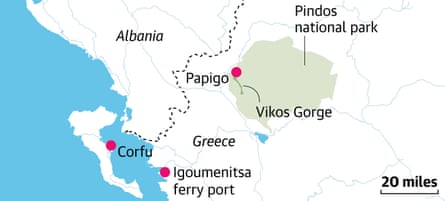
“Daisy,” I say, eyeing the snowy peaks rising heroically before us. “I’ve a feeling we’re not at sea level any more.” The little terrier sniffs at a biting cold wind. Imposing peaks called the Towers of Astraka dwarf the small hamlet of Papigo, which is perched at roughly 1,000 metres and reached by a road of hairpin turns.
The 2,400-metre ridges are part of the Tymfi massif in the mighty Pindus mountains, which extend south-east like a sturdy backbone from Albania to central Greece. We’re in Zagori in northern Greece: known as “the place behind the mountains”, it has been nominated for Unesco cultural landscape status, and it’s easy to see why. A scattering of tiny traditional towns cling to slopes and teeter over gorges, all linked by ancient pathways and lovely old stone bridges. And today, it’s Christmas-cake white.
Greece is mostly mountains: they cover 80% of the mainland. Who knew? Not me. I sailed here. I left Britain a few summers back, arrived in the Ionian Sea seeking empty horizons and quiet islands. Some hope. Better to ditch the coast and head for the skies. Up here, there’s breathing space, even in July. But off season? Then it’s as otherworldly as Narnia.

Thundering waterfalls, glacial alpine lakes, icy cold springs rushing into sparkling pools. Winter is truly, madly, deeply special. We hike trails where brown bears are, we hope, hibernating (this is one of Europe’s last strongholds) and keep an eye open, too, for wolves and lynx. I’m with my boyfriend and Daisy, his little staffy. Everywhere is blanketed in snow, folding and dazzling, pristine and empty. Like the sea once was, I imagine. We’re near 2,000 metres, almost as high as the gods on Olympus, and I don’t think I ever want to come down.
But even when we come down it’s spectacular, for at the bottom of the mountains the Earth splits open at Vikos Gorge, the “Greek Grand Canyon”, part of the Vikos-Aoös national park. Beloi is the third viewpoint we visit, after Oxya at Monodendri, and Vikos village. To my mind, Beloi offers the best perspective, showing the full length of the gorge as it cuts almost 20 miles to Vikos. It’s a view that is hard won. Normally it’s a 30-minute stroll from Vradeto village, but we arrive in knee-deep snow and trudge the closed road: despite wet boots, soggy socks and icy wind, my face is frozen in a stupid grin. While the other viewpoints are easily accessible, with a scattering of visitors, here, we are alone. This clifftop is all the more beautiful for the isolation.
Winter is not the obvious season to visit but it is surely the most magical and the adventurous can still seek out activities such as canyoning and rafting, guided hikes and horse-trekking. We explore signposted loops overhanging the gorge with breathtaking panoramas, and try two trails, from Vikos and from Vitsa, each under an hour down and about the same back. In good weather, the whole gorge can be hiked in six to eight hours; in winter, caution is wise. As at sea, storms can come out of nowhere.
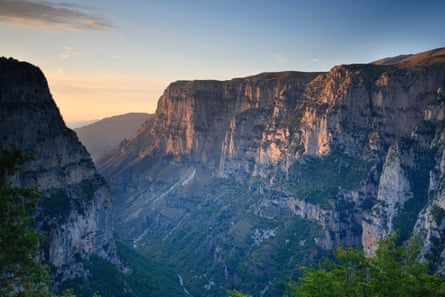
I gingerly test steps roughly hewn into the rocks and slippery with ice. But as we descend, the snow disappears until we’re in the verdant valley under a warm sun. Down here is the Voidomatis River, widely listed as one of the cleanest in Europe, where Vikos spring water is bottled.
From Monodendri village we walk to Petrino Dasos, where layered limestone towers sit like natural sculptures among the oaks and maples. Perfectly layered formations, carved over millennia, they are, legend has it, giants petrified by the gods.
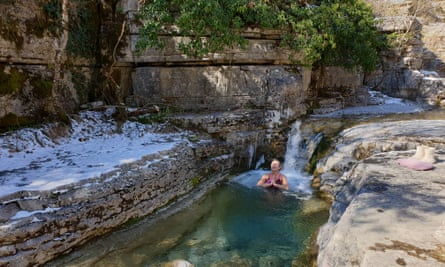
We stay in family-run En Chora Vezitsa guesthouse in Vitsa, overlooking the deepest part of the gorge, with just a few other weekend guests from Athens at this time of year. The next morning I’m in their henhouse searching for where the chickens hide their eggs. A pretty black hen is laying one right in front of me, to order. I clutch the still warm eggs and hurry back into the cosy kitchen where Maria beats them into a cheese pie as we chat.
She’s fresh from Athens herself, back to run this place for her parents, and excited about the lifestyle change. No more stifling city life: instead she’ll be taking people on hikes and foraging, offering cookery and yoga classes. She says she hopes guests will feel they’ve come to a friend’s house.
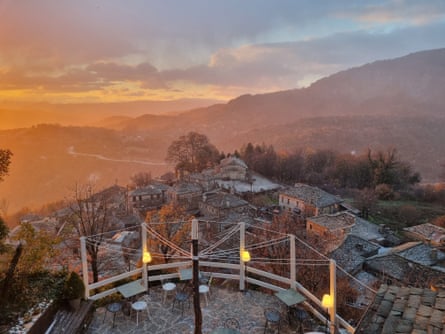
As she chats, the pie sizzles in the oven. Alevropita is a regional dish, a simple pizza-style pie with thin layers of batter containing yoghurt, feta, herbs and olive oil. I don’t so much eat as inhale it. Suddenly I see why they love their pies in the mountains. Spinach pie. Mushroom pie. Orange pie. It’s pie heaven up here.
after newsletter promotion
After breakfast, we head back to Papigo, the most timeless of all Zagori villages. Its roofs are heavy with snow, its chimneys whisper of warmth inside. And dominating the skyline are those unforgettable towers of Astraka. The hamlet is divided into Mikro and Megalo Papigo, and between the two are the Rogovo Ovires. Like precious stone, these deep spring pools flow through a smooth-walled gorge, one perfect plunge pool after another. Carved out by nature, they were enhanced by local people several decades ago, with sluices to control the water and offer cold swimming all summer. Ingenious.
In winter, the pools are overhanging with icicles and edged by snow, the rushing stream newly melted. I’ve had these crystal pools in my mind for the whole trip. I go in for a wake-up dip. The water is less than 3C. I float for several painful minutes with just a few small screams, woollen slippers and hot-water bottle waiting on the side.
After that, I rush back to our hotel, Unesco-listed Mikro Papigo 1700, which is as old as it says and as tasteful as you’d hope. It is perfectly preserved, like all of Papigo, with cobbled paths, stonework and wooden doors, its roofs in layered flat stones, each balanced by the weight of the one above.
The hotel sits on the approach to Astraka and Drakolimni (dragon lake) – which is home to tiny rare newts. I’m desperate to climb to the mountain refuge at 1,950 metres, but for that we’ll have to return when the snow has melted. In the meantime, we decide to wander “a little way” up the path. A few hours later, we can’t seem to stop. It’s one of those days. Bright blue and white, all sky and snow. On we go.
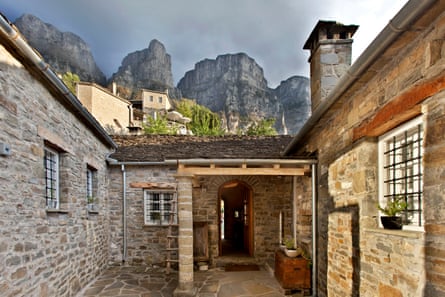
We meet a couple of backcountry skiers, glowing on their way down, and before we know it, we’re past the halfway point. We’re also up to our thighs in snow.
As the light starts to fade on the descent, we’re very glad of our first sight of the 1700, though the beautiful building is a little wasted on my tired eyes. I’m obsessing over what’s inside it: an eco-spa fed by that silky spring water. Here it’s heated, though. I sink in, sending thanks to the gods.
Accommodation was provided by En Chora Vezitsa (doubles from £65 B&B) and Mikro Papigo 1700 (doubles from £110 B&B) Alpine Zone (alpinezone.gr) offers rafting, canyoning, skiing, horse trekking and guided walks all year round



